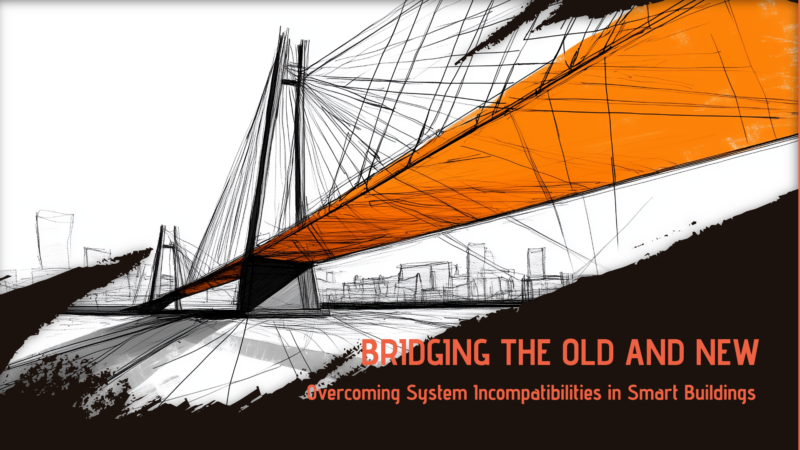 As more commercial buildings adopt smart technologies, integrating these modern systems with existing legacy infrastructure is becoming a critical challenge. Many buildings rely on older systems that weren’t designed to communicate with today’s technologies such as IoT devices, AI-driven automation, and cloud-based platforms that are powering today’s smart buildings. When these systems aren’t compatible, it can limit the benefits of new technologies, create operational inefficiencies, and even increase maintenance costs.
As more commercial buildings adopt smart technologies, integrating these modern systems with existing legacy infrastructure is becoming a critical challenge. Many buildings rely on older systems that weren’t designed to communicate with today’s technologies such as IoT devices, AI-driven automation, and cloud-based platforms that are powering today’s smart buildings. When these systems aren’t compatible, it can limit the benefits of new technologies, create operational inefficiencies, and even increase maintenance costs.
This week’s edition of Building Tomorrow will explore the complexities of bridging the gap between legacy and smart systems and outline practical strategies for building owners and operators to achieve seamless integration. By finding ways to connect the old with the new, developers can upgrade their properties, enhance tenant experience, and unlock the full potential of smart building solutions.
The Role of PropTech in Redefining Tenant Experience | Layer 10
Identifying Common Incompatibility Issues
Integrating new smart technologies with older systems in commercial buildings can be challenging due to various incompatibility issues. Many legacy systems rely on outdated hardware and software that aren’t built to interface with IoT devices or cloud-based platforms. Limited interoperability can prevent these systems from seamlessly sharing data, which disrupts building operations and reduces the efficiency of smart technologies.
Older HVAC or lighting systems, for instance, may lack the necessary interfaces to communicate with AI-driven management platforms.
“Outdated hardware and software limitations are often the biggest barriers to unlocking the full potential of smart building solutions.”
Such incompatibilities can limit real-time monitoring, prevent predictive maintenance, and reduce tenant comfort, underscoring the need for thoughtful integration strategies. To explore the broader risks of relying on legacy systems, read Legacy Systems: How Outdated Tech Can Poison Your Business.
Strategies for Bridging Legacy and New Systems
Successfully integrating legacy systems with new smart technologies requires a thoughtful approach to compatibility. One effective method is the use of middleware solutions and API integrations. These act as bridges, allowing older systems to communicate with IoT devices, data platforms, and other modern tools. Modular upgrades are also a practical option, enabling buildings to adopt smart technologies incrementally without overhauling existing systems.
“Flexible solutions like middleware and modular upgrades create a pathway to modernizing buildings without costly replacements.”
These scalable and adaptable approaches prepare buildings for future upgrades, ensuring that technology investments remain valuable as advancements continue.
The Digital Transformation of Building Operations | Layer 10
Ensuring Long-Term Compatibility and Future-Readiness
Achieving long-term compatibility for smart building systems requires proactive planning and the right tools. Investing in scalable technology and regularly assessing infrastructure allows developers to keep systems compatible with new advancements. A best practice is to choose cross-platform solutions that work with a wide range of devices and software, making it easier to integrate future updates seamlessly.
“Future-readiness in smart buildings isn’t just about today’s technology—it’s about creating a system that evolves alongside new innovations.”
Implementing these practices helps properties stay adaptable and maintain operational efficiency over time.
The Intersection of Design and Technology: Crafting Future-Ready Spaces | Layer 10
Conclusion: The Benefits of a Unified System in Smart Buildings
Integrating legacy systems with new smart technologies ensures that buildings remain adaptable and efficient as advancements continue. By using scalable solutions, middleware, and cross-platform systems, developers can bridge compatibility gaps, future-proofing properties against obsolescence. A unified system not only enhances operational efficiency but also creates a seamless experience for tenants, improving satisfaction and building value over the long term. Public-private partnerships (P3s) can also play a critical role in funding and powering such infrastructure improvements. Embracing these strategies today is essential for developing smart buildings that can keep up with tomorrow’s technology.
Are your buildings ready to bridge the gap between legacy systems and new smart technologies? Future-proof your property with scalable solutions that maintain compatibility and enhance tenant experience. Let Layer 10 guide you through the process, from integrating middleware solutions to selecting cross-platform systems that ensure seamless functionality.
Contact us today to learn how we can help you create a unified, future-ready building system.
Let’s build tomorrow, today.